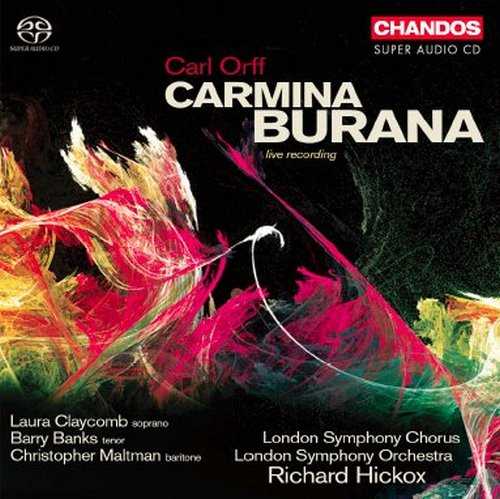
Composer: Carl Orff
Performer: Laura Claycomb, Barry Banks, Christopher Maltman, Tiffin Boys Choir
Orchestra: London Symphony Orchestra
Conductor: Richard Hickox
Audio CD
Number of Discs: 1
Format: FLAC (tracks)
Label: Chandos
Size: 1.04 GB
Recovery: +3%
Scan: yes
01. Fortuna Imperatrix Mundi: O Fortuna
02. Fortuna Imperatrix Mundi: Fortune plango vulnera
03. Primo vere: Veris leta facies
04. Primo vere: Omnia sol temperat
05. Primo vere: Ecce gratum
06. Uf dem anger: Tanz
07. Uf dem anger: Floret Silva
08. Uf dem anger: Chramer, gip die varwe mir
09. Uf dem anger: Reie
10. Uf dem anger: Were diu werlt alle min
11. In taberna: Estuans interius
12. In taberna: Olim lacus colueram
13. In taberna: Ego sum abbas
14. In taberna: In taberna quando sumus
15. Cour d’amours: Amor volat undique
16. Cour d’amours: Dies, nox et omnia
17. Cour d’amours: Stetit puella
18. Cour d’amours: Circa mea pectora
19. Cour d’amours: Si puer cum puellula
20. Cour d’amours: Veni, veni, venias
21. Cour d’amours: In trutina
22. Cour d’amours: Tempus est iocundum
23. Cour d’amours: Dulcissime
24. Blanziflor et Helena: Ave formosissima
25. Fortuna Imperatrix Mundi: O Fortuna
Recorded live at the Barbican Centre in November 2007, Richard Hickox conducts Carl Orff’s immensely popular dramatic cantata Carmina Burana with the London Symphony Orchestra and Chorus and soloists, Barry Banks, Laura Claycomb and Christopher Maltman.
Orff is reputed to have declared around the time of Carmina’s first performance, ‘Everything I have written to date, and which you have printed, can be destroyed. With Carmina Burana, my collected works begin.’ He had a strong interest in theatrical presentations and conceived the work as a pageant. The idea came to Orff in 1935 when he encountered an edition of medieval songs edited by the poet Johann Schmeller. The vivid and colourful songs were those sung by the goliards – hedonistic students and traveling monks who celebrated their riotous pursuits in bawdy and profane poetry. The 24 ‘cantiones profanae’ chosen by Orff were translated and the composer set them to music for three vocal soloists, three choirs and a large orchestra featuring triple woodwind, two pianos and no fewer than five percussionists.
The score’s combination of gloriously infectious vulgarity interspersed with moments of genuine beauty has assured it an unquestionable position as one of the most popular of all twentieth-century choral works.



